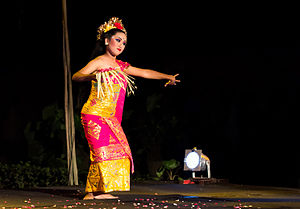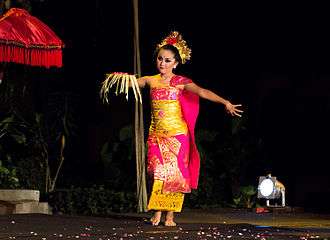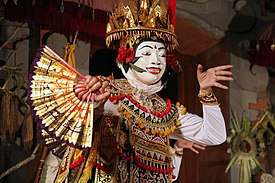Panyembrama
Panyembrama is a secular Balinese dance form designed by I Wayan Berata and first performed in 1971. It includes movements from several sacral Balinese dances, which it was intended to replace for performance in front of tourists.
 A panyembrama dancer | |
| Origin | Indonesia |
|---|---|
| Panyembrama |
|---|
|
| Burma |
| Cambodia |
|
| Indonesia |
|
| Laos |
| Malaysia |
| Philippines |
| Thailand |
| Vietnam |
History
Traditional Balinese dances are sacral in nature, and thus unsuited for secular performances. That these dances were used for welcoming non-Balinese, and in non-sacral contexts, was a point of controversy in the late 1960s.[1] A secular dance was needed, one which could be used outside of the temples, particularly for tourists, and thus maintain the sacredness of the original dances.[2] Panyembrama was one of several dance forms, including oleg tamulilingan, which arose from this situation and was intended for non-Balinese (particularly Western) audiences.[3]
I Wayan Beratha, a choreographer with the Karawitan Conservatory (Indonesian: Konservatori Karawitan) who was well-versed in traditional Balinese dance, was tasked by his organisation to create a new, secular dance.[4] To create what would become panyembrama, Beratha combined the most beautiful moves of traditional dances such as legong, condong, and pendet.[2][5][6] Ethnomusicologist Zachar Laskewicz writes that the continued inspiration of these dances allows similar texts to be interpreted from the panyembrama performance.[7] This basis in traditional dance has also led to panyembrama being classified as a form of classical dance by the art critic A. M. Hermin Kusmayati.[8]
Panyembrama was first performed in 1971, at the Pandan Festival.[5] This dance form has been taught at Balinese dance schools,[6] and been used at temples in religious ceremonies, as a sort of welcoming dance for the gods.[4][9]
Performance

The name panyembrama, from the Balinese word sambrama, means "welcome". This is reflective of its purpose as a welcoming dance.[7] In lengthy events, the dance is usually performed first, particularly before a secularised legong dance.[8]
The dancers – always young women – come onstage carrying a metal (usually silver or aluminium) dish with incense and flowers in it.[8] These dancers, numbering two or more, wear layered clothing, decorated with a golden pattern called prada. Around their bodies they wear a kamben (sarong), as well a tightly wrapped cloth which covers from their chest to their waist. On their heads they wear golden headdresses and frangipani flowers.[10]
To open the panyembrama dance, the performers kneel, as if praying.[10] They make welcoming movements to the guests,[7] accompanied by gamelan. Their movements are slow, accentuating the curves of the dancers' bodies.[10] At the end of the performance, the dancers move in circles, throwing flowers at each other and the audience, with the scents being carried in the air.[7][10] Unlike some other Balinese dances, panyembrama is not intended to convey a story.[10]
See also
References
- Barker, Putra & Wiranatha 2006, p. 218.
- Laskewicz 2003b, p. 31.
- Picard 2006, p. 216.
- Picard 2006, p. 230.
- Tanjung 2012.
- Heimarck 2003, p. 179.
- Laskewicz 2003a, p. 59.
- Kusmayati 1992, pp. 110–111.
- Suardana 2012, p. 16.
- Suardana 2012, p. 17.
Works cited
- Barker, Tanuja; Putra, Darma; Wiranatha, Agung (2006). "Authenticity and Commodification of Balinese Dance Performances Tanuja Barker, Darma Putra & Agung. Wiranatha". In Mike Robinson; Melanie K Smith (eds.). Cultural Tourism in a Changing World. Tourism and cultural change. 7. New York: Channel View Publications. pp. 215–24. ISBN 978-1-84541-044-5.CS1 maint: ref=harv (link)
- Laskewicz, Zachar (2003a). "From the Hideous to the Sublime: Olfactory Processes, Performance Texts, and the Sensory Episteme". Performance Research. 31 (8): 55–65. ISSN 1469-9990.CS1 maint: ref=harv (link)
- Laskewicz, Zachar (2003b). Music as Episteme, Text, Sign and Tool: Comparative Approaches to Musicality as Performance. Seattle: Saru. ISBN 978-0-935086-35-5.CS1 maint: ref=harv (link)
- Heimarck, Brita Renee (2003). Balinese Discourses on Music and Modernization: Village Voices and Urban Views. Current research in ethnomusicology. 5. New York: Routledge. ISBN 978-0-415-94208-9.CS1 maint: ref=harv (link)
- Kusmayati, A.M. Hermin (1992). "Tari Daerah" [Regional Dance]. In Soedarsono (ed.). Pengantar Apresiasi Seni [Introduction to Art Appreciation] (in Indonesian). Jakarta: Balai Pustaka. OCLC 29591251.CS1 maint: ref=harv (link)
- Picard, Michel (2006). Bali: Pariwisata Budaya dan Budaya Pariwisata [Bali: Culture Tourism and Tourism Culture]. Jakarta: Kepustakaan Populer Gramedia. ISBN 978-979-9100-58-0.CS1 maint: ref=harv (link)
- Suardana, Kartika D (2012). Dances of Bali. Kuta: Now! Bali. ISBN 978-602-97971-1-4.CS1 maint: ref=harv (link)
- Tanjung, Intan (7 October 2012). "Stories within dances". The Jakarta Post. Archived from the original on 8 November 2014. Retrieved 8 November 2014.CS1 maint: ref=harv (link)
.svg.png)

